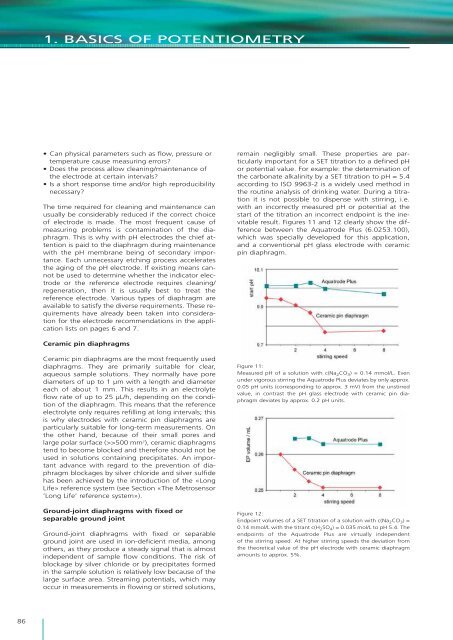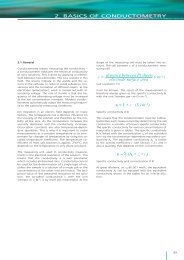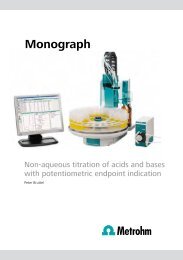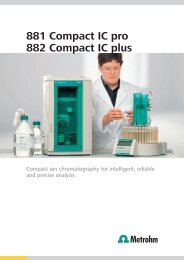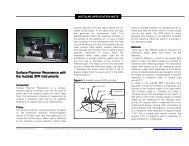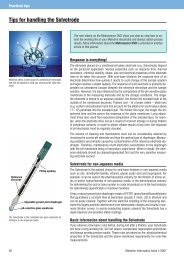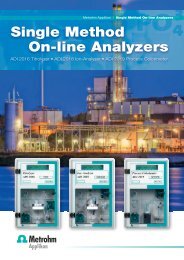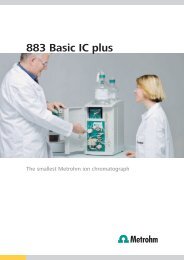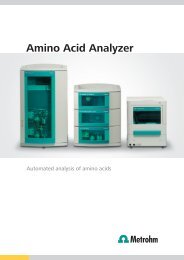What is the theoretical background of potentiometry? - Metrohm
What is the theoretical background of potentiometry? - Metrohm
What is the theoretical background of potentiometry? - Metrohm
Create successful ePaper yourself
Turn your PDF publications into a flip-book with our unique Google optimized e-Paper software.
1. BASICS OF POTENTIOMETRY• Can physical parameters such as flow, pressure ortemperature cause measuring errors?• Does <strong>the</strong> process allow cleaning/maintenance <strong>of</strong><strong>the</strong> electrode at certain intervals?• Is a short response time and/or high reproducibilitynecessary?The time required for cleaning and maintenance canusually be considerably reduced if <strong>the</strong> correct choice<strong>of</strong> electrode <strong>is</strong> made. The most frequent cause <strong>of</strong>measuring problems <strong>is</strong> contamination <strong>of</strong> <strong>the</strong> diaphragm.Th<strong>is</strong> <strong>is</strong> why with pH electrodes <strong>the</strong> chief attention<strong>is</strong> paid to <strong>the</strong> diaphragm during maintenancewith <strong>the</strong> pH membrane being <strong>of</strong> secondary importance.Each unnecessary etching process accelerates<strong>the</strong> aging <strong>of</strong> <strong>the</strong> pH electrode. If ex<strong>is</strong>ting means cannotbe used to determine whe<strong>the</strong>r <strong>the</strong> indicator electrodeor <strong>the</strong> reference electrode requires cleaning/regeneration, <strong>the</strong>n it <strong>is</strong> usually best to treat <strong>the</strong>reference electrode. Various types <strong>of</strong> diaphragm areavailable to sat<strong>is</strong>fy <strong>the</strong> diverse requirements. These requirementshave already been taken into considerationfor <strong>the</strong> electrode recommendations in <strong>the</strong> applicationl<strong>is</strong>ts on pages 6 and 7.remain negligibly small. These properties are particularlyimportant for a SET titration to a defined pHor potential value. For example: <strong>the</strong> determination <strong>of</strong><strong>the</strong> carbonate alkalinity by a SET titration to pH = 5.4according to ISO 9963-2 <strong>is</strong> a widely used method in<strong>the</strong> routine analys<strong>is</strong> <strong>of</strong> drinking water. During a titrationit <strong>is</strong> not possible to d<strong>is</strong>pense with stirring, i.e.with an incorrectly measured pH or potential at <strong>the</strong>start <strong>of</strong> <strong>the</strong> titration an incorrect endpoint <strong>is</strong> <strong>the</strong> inevitableresult. Figures 11 and 12 clearly show <strong>the</strong> differencebetween <strong>the</strong> Aquatrode Plus (6.0253.100),which was specially developed for th<strong>is</strong> application,and a conventional pH glass electrode with ceramicpin diaphragm.Ceramic pin diaphragmsCeramic pin diaphragms are <strong>the</strong> most frequently useddiaphragms. They are primarily suitable for clear,aqueous sample solutions. They normally have porediameters <strong>of</strong> up to 1 μm with a length and diametereach <strong>of</strong> about 1 mm. Th<strong>is</strong> results in an electrolyteflow rate <strong>of</strong> up to 25 μL/h, depending on <strong>the</strong> condition<strong>of</strong> <strong>the</strong> diaphragm. Th<strong>is</strong> means that <strong>the</strong> referenceelectrolyte only requires refilling at long intervals; th<strong>is</strong><strong>is</strong> why electrodes with ceramic pin diaphragms areparticularly suitable for long-term measurements. On<strong>the</strong> o<strong>the</strong>r hand, because <strong>of</strong> <strong>the</strong>ir small pores andlarge polar surface (>>500 mm 2 ), ceramic diaphragmstend to become blocked and <strong>the</strong>refore should not beused in solutions containing precipitates. An importantadvance with regard to <strong>the</strong> prevention <strong>of</strong> diaphragmblockages by silver chloride and silver sulfidehas been achieved by <strong>the</strong> introduction <strong>of</strong> <strong>the</strong> «LongLife» reference system (see Section «The Metrosensor’Long Life’ reference system»).Ground-joint diaphragms with fixed orseparable ground jointGround-joint diaphragms with fixed or separableground joint are used in ion-deficient media, amongo<strong>the</strong>rs, as <strong>the</strong>y produce a steady signal that <strong>is</strong> almostindependent <strong>of</strong> sample flow conditions. The r<strong>is</strong>k <strong>of</strong>blockage by silver chloride or by precipitates formedin <strong>the</strong> sample solution <strong>is</strong> relatively low because <strong>of</strong> <strong>the</strong>large surface area. Streaming potentials, which mayoccur in measurements in flowing or stirred solutions,Figure 11:Measured pH <strong>of</strong> a solution with c(Na 2 CO 3 ) = 0.14 mmol/L. Evenunder vigorous stirring <strong>the</strong> Aquatrode Plus deviates by only approx.0.05 pH units (corresponding to approx. 3 mV) from <strong>the</strong> unstirredvalue, in contrast <strong>the</strong> pH glass electrode with ceramic pin diaphragmdeviates by approx. 0.2 pH units.Figure 12:Endpoint volumes <strong>of</strong> a SET titration <strong>of</strong> a solution with c(Na 2 CO 3 ) =0.14 mmol/L with <strong>the</strong> titrant c(H 2 SO 4 ) = 0.035 mol/L to pH 5.4. Theendpoints <strong>of</strong> <strong>the</strong> Aquatrode Plus are virtually independent<strong>of</strong> <strong>the</strong> stirring speed. At higher stirring speeds <strong>the</strong> deviation from<strong>the</strong> <strong>the</strong>oretical value <strong>of</strong> <strong>the</strong> pH electrode with ceramic diaphragmamounts to approx. 5%.86


